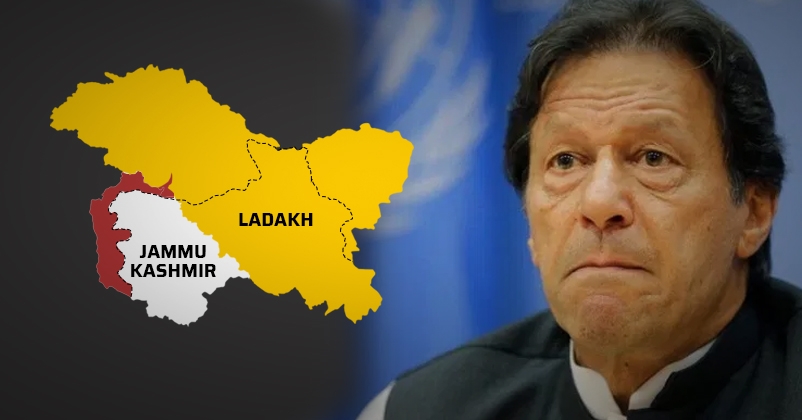Azad Jammu Kashmir (POJK) – An illusion of Pakistan
21 Feb 2020 19:29:09

It is a legal fact that it was British India which was partitioned on communal basis not Princely States. The preamble of AJK's Constitution reads, "The State of Jammu and Kashmir under the instrument of partition should have formed the part of Pakistan, as majority rather predominant part of its population, is Muslim.” It reflects the policy bankruptcy of so-called AJK and Pakistan.
Pakistan tries to build an opinion that the Mirpur Muzaffarabad is not part of Jammu and Kashmir by portraying POJK as Azad. The so-called AJK and Gilgit Baltistan have been kept separate, so that dissatisfaction regarding their political rights and economic well-being can be contained in respective regions and thus reduces the threat of consolidated movement against Pakistan. Pakistan continuously propagates that final status of Jammu Kashmir is yet to be determined in accordance with the wishes of people but till then, State's accession to Pakistan is final and its cannot be questioned.
Mirpur Muzaffarabad – working of the Government of POJK
In 1974, the parliamentary system was introduced in this region under the Interim Constitution Act, 1974. President is the constitutional head under the interim constituent ACT 1974. The Prime Minister is elected by the members of the legislative assembly. Prime Minister is the Chief Executive of the State. The Legislative Assembly consists of 41 elected Members and 8 co-opted members of which 5 are ladies, one member from Ullema-e-Din or Mushaikh, while one is from amongst Jammu & Kashmir technocrats and other professionals, whereas one is from amongst Jammu and Kashmir nationals (state subjects) residing abroad.
The Karachi agreement signed between Pakistan and ‘Azad Kashmir' government limited the role of AJK Government in Northern areas/Gilgit Baltistan.
Gilgit Baltistan is governed by Ministry of Kashmir and frontier affairs from 1949 to 1970. Pakistan was ruling the area through Joint secretary responsible to the Ministry of KANA. In 1994 the federal Government allowed the political parties of Pakistan in Gilgit Baltistan but did not allowed parties from so called AJK.
AJK (POJK) is not part of Pakistan: Its Supreme Court’s, Constitutional and Legal Position
Chief Justice of POJK, while heading a three-member bench on March 15, 2010, passed an order. The order states, “The Supreme Court of Pakistan has no jurisdiction to entertain any petition regarding appointment of Judges of superior courts of AJK. Such kind of petition does not come within the jurisdiction and sphere of Supreme Court of Pakistan,” The order further states, “The Supreme Court of Pakistan has no authority to extend their jurisdiction to the area of Azad Jammu Kashmir and Kashmir because the territories of Pakistan have been defined in article 1 of the constitution of Islamic Republic of Pakistan. The Supreme Court of Pakistan cannot go beyond the territories defined in article 1 of the constitution of Islamic Republic of Pakistan.
A written statement signed by advocates general of Pakistan who was instructed through a letter, No.MQ/351824/91 of November 10, 1991 states, according to constitution of Pakistan Northern Areas were never part of Pakistan. According to the constitution of 1973 of Pakistan, Northern Areas are not part of Pakistan. Northern Areas are historically, geographically, constitutionally and legally part of Jammu & Kashmir and will remain so. Northern Areas are inseparable part of J&K and its control is with Pakistan under an agreement, but Northern Areas are not part of Pakistan.
The contents of the letter No. PS-400/89 of march 17, 1989 addressed by president of AJK to the President of Islamic Republic of Pakistan states, The control of Northern Areas was temporarily handed over to Pakistan. According to UN resolutions Northern Areas are part of J&K. The circumstances under which the agreement of transfer of control of Northern Areas to Pakistan took place, have changed. So the said agreement should be reviewed. According to census reports of 1911, 1921, 1931 and 1941 of govt of India Northern Areas are part of J&K. In 1925 government of J&K undertook settlement of revenue according to the settlement Northern Areas are part of J&K. Maps published in February 1953 by ministry of Kashmir affairs of Pakistan shown Northern Areas as part of Jammu and Kashmir. This map was reproducing in 1987.
The Legal and Constitutional Status of J&K according to the Constitution of Pakistan
At the time of partition, the territories which comprised Pakistan, were East Bengal, West Punjab, Province of Sind, Chief Commissioner’s provinces of British Baluchistan, North west Frontier Province and the territories of such other States which acceded to Pakistan.
The territorial areas of Pakistan were elaborated in the Constitution of Islamic Republic of 1956, 1962 and 1973. In the present Constitution, under section (2) the territories of Pakistan were listed as- The provinces of Baluchistan, North West frontier, the Punjab and Sind, the Islamabad capital territory, the Federally Administered Tribal Areas (FATA) and such States and territories as are or may be included in Pakistan, whether by accession or otherwise.
It is clear from the above-mentioned description of territories of Pakistan that POJK\POTL or, for that matter, any part of Jammu and Kashmir are not part of Pakistan. So sooner Pakistan realizes this, the better.